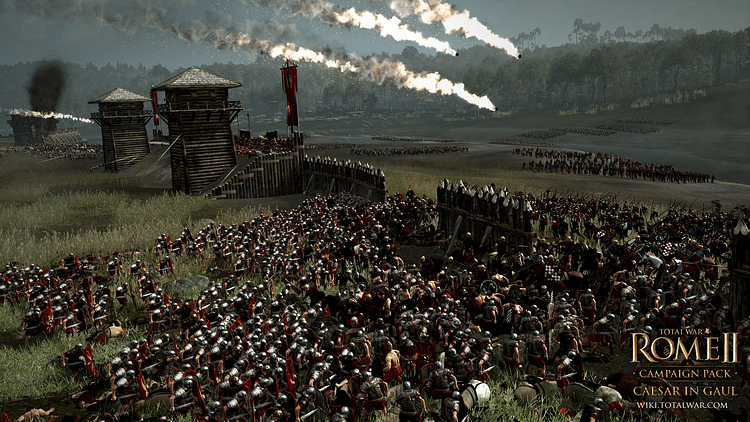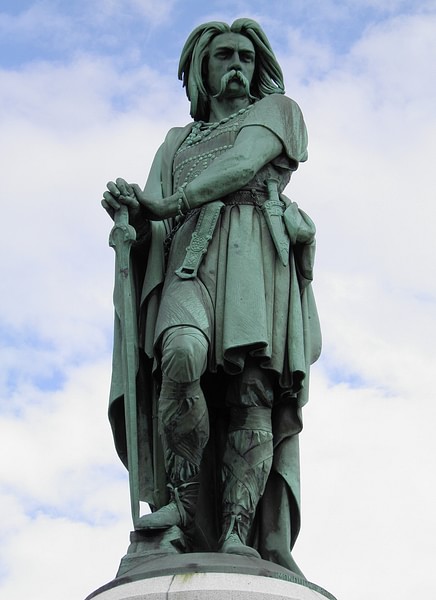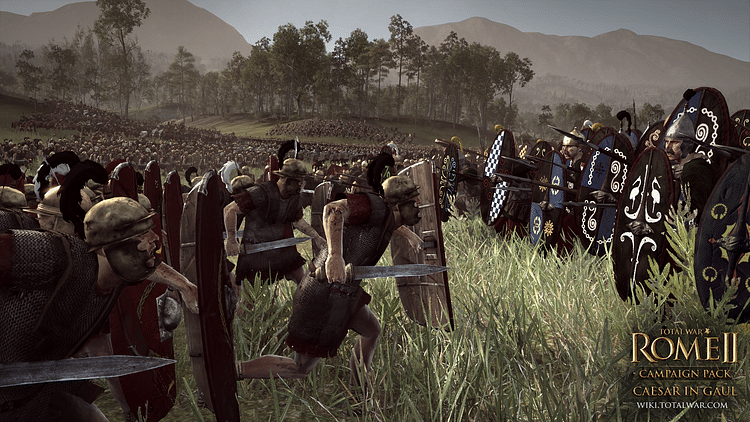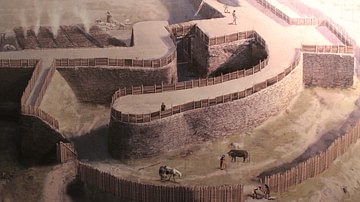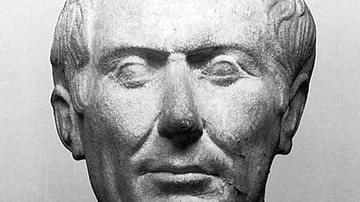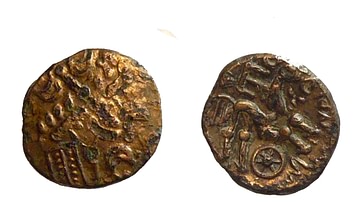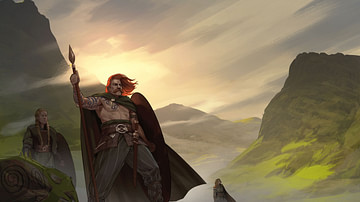The Battle of Alesia was a decisive Roman victory in Julius Caesar's Gallic Wars in September 52 BCE. Roman commander Julius Caesar (100-44 BCE) and his legions faced a united Gallic army under the command of Vercingetorix (82-46 BCE), chief of the Arverni, at the hilltop fort or oppidum of Alesia, in modern-day eastern France.
In an impressive feat of Roman siege warfare, Caesar's army built dual fortification lines around the fort, cutting off the besieged Gauls from reinforcement. Although a worthy opponent, Vercingetorix's forces were defeated by the Roman army, and the battle, which was arguably Caesar's greatest military achievement, marks the end of Gallic independence.
Caesar's Campaign in Gaul
Caesar’s campaign into Gaul began when the Helvetii migrated from their homeland in search of more fertile land for their growing population. When they moved into Transalpine Gaul and requested permission to cross, Caesar, acting as the region’s proconsul, decided to prevent their incursion into Roman territory and refused their request. Although the Helvetii sought peace and guaranteed their good conduct, Caesar waited three weeks before deciding to wage war. In his own words, referring to himself in the third person, Caesar recounted the innocent plea of the Helvetii, stating that "their sole intention was to march through the Province without causing any disturbance of the peace, and only for the reason that no other route lay open to them, and that for this they humbly solicited his leave" (Conquest of Gaul, 5). Innocent or not, Caesar easily dismissed their request.
In defense of his attack against the Helvetii, he claimed he was defending the Roman Republic from aggression, for the Helvetii had been the aggressors against several Roman-allied tribes. Despite an uproar in the Roman Senate led by Caesar’s nemesis Cato the Younger (95-46 BCE), Caesar, with a force of five legions, fought against the Helvetii and was victorious, forcing the battered tribe to return home. There are those who claim his war with the Helvetii was only an excuse to march into Gaul. Holland remarked that Caesar was famous amongst the Roman people for his clemency but "more famous for his love of glory - and in such a cause the whole of Gaul and beyond had been made to bleed" (272).
Appearance of Vercingetorix
After the defeat of the Helvetii, Caesar and his four legions - VII, VIII, IX, and X - remained in Gaul. He would eventually command twelve legions during his decade in Gaul – Legio XIV would be ambushed and destroyed in their winter quarters but later reconstituted. During this time, he received requests for assistance from a number of Gallic tribes. Numbering 120,000, the German tribes Usipetes and Tencteri had crossed into Gaul. Caesar quickly responded and soundly defeated the invaders. Having won two decisive victories, he divided his forces in order to undertake several minor campaigns, and in 55 BCE, he bridged the Rhine. One year later he crossed over into Britain for the second time taking with him five legions. Although he had helped defeat the German invaders, his aggressive actions elsewhere alarmed many throughout Gaul. Tension was growing.
The Belgae and Nervii rose up, inflicting damage on several Roman settlements and forcing Caesar to withdraw from Britain. Realizing he had a fight on his hands, Caesar was able to regain control and suppress the rebellion. For a while, things remained quiet. However, the Gauls finally realized they were far too disorganized and decided to unite under one leader in order to defend themselves against Rome. They chose the Arverni chief Vercingetorix. The new leader trained the Gauls hard - most Gallic warriors were only armed with a spear and shield - and in 53 BCE, after a series of minor raids against Roman towns, he led an attack against the Roman settlement at Cenabum, killing the entire Roman population and capturing a large store of grain.
Caesar rallied his legions, and in January of 52 BCE, he marched to Cenabum, recapturing the town from the Gallic forces. With spring approaching, Vercingetorix decided that instead of battling Caesar, he would starve him out and ordered all food and forage to be destroyed, denying Caesar the necessary supplies. The losses suffered by the Gauls at such towns as Cenabum had caused Vercingetorix to summon his supporters into council and discuss the situation. Although Caesar was not in attendance, he wrote of the meeting, quoting the Gallic chief:
The supreme object of the Gauls should be to deprive the Romans of fodder and provisions, and owing to their superior cavalry, as well as to the time of the year, neither of these tasks should present much difficulty. (178)
Throughout the months leading to the final battle at Alesia, the Romans were in constant search of provisions, but Caesar proudly spoke of the strength of the legions. Although often starving, "…no word was uttered unworthy of the great traditions of the Roman people." (179). Demanding grain from Roman allied tribes, Caesar’s next move was to go to Gorgobina where the Gauls were besieging the city. As he and his legions marched toward the city, he destroyed small Gallic strongholds such Noviodunum along the way, seizing essential food supplies.
With Caesar approaching, Vercingetorix ceased his raid, deciding to confront the Roman army elsewhere. With the siege of the city ended, Caesar advanced on to Avaricum in central Gaul. After his arrival at Avaricum, using old assault techniques from Greek warfare, Caesar built a large siege ramp and pushed two towers close to the enemy wall. The attack on Avaricum was supported by Roman artillery at the base of the ramp. Although food was running low, he easily captured the town. As the Romans climbed over the walls and into the city, the Gauls "became seized with panic lest all exits should be stopped, and flinging away their arms, rushed in wild disorder for the furthest corner of the town" (The Conquest of Gaul, 187). Caesar recounted the plunder of the city:
No one thought of the plunder, but maddened by the recollection of the massacre at Cenabum, as well as by the hardship and privations of the siege, the troops were altogether without mercy. (187)
The old and infirmed as well as women and children were massacred. The few survivors of the deadly siege fled to Gergovia. Vercingetorix had decided wisely not to engage Caesar in battle but to wait. However, with their own provisions running low, the Gauls finally grew impatient and advanced towards the city. Caesar refused to respond to their threat, realizing it would be far too costly. Marching away from the city and with sufficient provisions, Caesar conducted raids against small Gallic towns, finally approaching Gergovia, capital of Vercingetorix’s tribe. Forced to split his forces to fight elsewhere, he had to withdraw from the town due to lack of food supplies and heavy casualties. Unfortunately for the Romans, old Gallic allies slowly began to abandon Caesar. Strengthened by reinforcements, Vercingetorix advanced to the hilltop town of Alesia where he would finally confront Caesar. Although the estimate of the size of any army in battle is often exaggerated, Alesia pitted the Roman legions of an estimated 70,000 troops (or 50,000-55,000 in other sources) against the combined Gallic forces under the leadership of Vercingetorix of 80,000 infantry and 15,000 cavalry.
Fortifications at Alesia
The fortress town of Alesia was built on the top of Mt. Auxois, near the source of the Seine River and surrounded by the rivers Ose and Oserain. Caesar described the town in his Gallic Wars:
The town of Alesia, at which the two rival armies had now met for the final conflict, was perched on the summit of a high plateau, so steep that its capture otherwise than my investment was practically impossible… (216)
Immediately upon his arrival, Vercingetorix ordered a trench be dug between the two rivers (Caesar called them streams) so the approach to the town and camp would be difficult. Next, he sent his cavalry northward to harass and delay the Romans' approach, meeting Caesar’s cavalry at Vingeanne. Although the Gauls suffered heavy losses, they were able to delay the Romans long enough for Vercingetorix to bring the area’s cattle into his camp. He also sent his cavalry to bring reinforcements from neighboring tribes. While he had a substantial army sitting atop the hill, he only had 30 days of essential supplies.
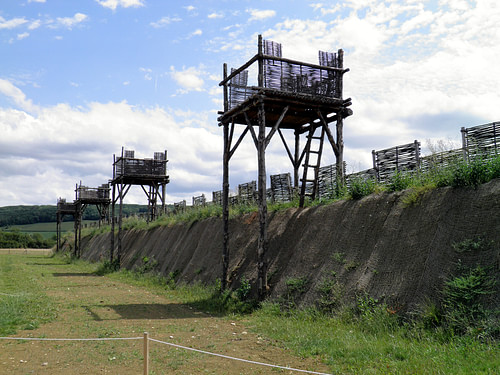
Upon his arrival at Alesia, Caesar began the difficult task of building field fortifications. His legions had become very good at combat engineering and contained specialized and skilled craftsmen as well as the necessary manpower to serve as a labor force. Creating an entire ring of defense was his first duty. His men built an eleven-mile (18 km) line of circumvallation around the Gallic camp to prevent anyone from escaping to bring in essential supplies. Digging ditches was nothing new to a Roman legionary. Every night, while on campaign, it was standard procedure to dig a trench and erect palisades to prevent a possible attack.
Realizing the possibility of Gallic reinforcement arriving at the rear, he built a second line of contravallation of 14 miles (22.5 km) long, facing outward to prevent a Gallic attack from the outside. In addition, he built a trench 20 feet (6 m) wide around the Gallic position to slow down any possible advance on the Roman fortifications - two more ditches were built with some parts flooded. Dirt from the trenches was used to build the rampart upon which was constructed a wooden palisade. In front of the palisades were rows of obstacles. There were five rows of sharpened stakes called clippi or tombstones woven together to prevent uprooting. Within v-shaped pits were stakes called lilia. There were also iron-barbed stakes called stimuli, diagonally embedded into the ground. Besides the trenches, Caesar ordered an earth-and-timber wall 12 feet (3.5 m) tall with towers every 80 feet (24 m) – 33 in total.
The Battle
Hoping for his relief to arrive, Vercingetorix killed time with minor attacks on the Roman defenses. Next, in order to safeguard supplies, he expelled all unnecessary people - mostly women and children - from the camp. Begging for mercy from Caesar - which they did not receive - they were left to starve between the two camps. About this time, the anticipated Gallic relief arrived - 250,000 infantry and 8,000 cavalry (Caesar’s estimates) - forcing the Roman commander to defend his rear from the outside. As the Gauls attempted to fill in the ditches, Caesar’s cavalry fought the enemy forces on a plain outside the camp. Caesar wrote:
All through the afternoon the battle raged blindly, victory inclining now this way and now that … (but) the Roman horsemen pushed their pursuit almost as far as the enemy’s entrenchment. Thus the first round of the great contest was over … (227)
He added that the Gauls had hoped to witness a victory but "with heavy hearts" returned to the city.
The following night the Gallic relief forces attacked the Roman rear while Vercingetorix stormed from the front using arrows, javelins, and sling stones trying to get a foothold on the fortifications. Caesar wrote that the Gauls startled "the night with a shout" and "suddenly opened upon the Roman guards a tremendous fire of sling bolts, arrows, and stones, intended to sweep them from the ramparts" (277). Using javelins and siege engines called scorpions, the Romans responded. Roman reinforcements, under the command of Mark Antony (83-30 BCE) were able to stabilize the rear and drive the Gauls back.
The following day the Gauls staged a two-prong attack: one assault was on a Roman fort believed to be the weakest point of the Roman position while a second was a diversionary assault on various points on the Roman front line. Caesar called up reserves elsewhere on the line and sent five cohorts under the Roman commander Labienus to reinforce the besieged fort. Realizing this might be his last opportunity, Vercingetorix ordered an all-out assault on the Roman line. A barrage of missiles drove the legionaries back. The Gallic forces began destroying Roman defenses, even gaining on the walls.
The Roman commander [Caesar speaking of himself] elsewhere strove to animate the defense by a personal visit to the trenches; where, appealing to his sorely harassed men not to succumb beneath the trial … on that hour hung the fruit of all their victories. (The Conquest of Gaul, 230)
Caesar ordered a counter-attack led by Decimus Brutus. Desperation still reigned, so Caesar ordered Gaius Fabius to Brutus’ aid with all available troops. Caesar wrote that "he himself led up to their support a third body of reserves. This turned the scale in favor of the Romans, and the enemy being here definitely repulsed…" (231). Meanwhile, the cavalry attacked the Gallic rear. Together, the Romans were able to regain the offensive. The Gallic forces weakened. Caesar sent additional troops to bolster the legions at the besieged fort. With the support of the German cavalry, the Romans were able to push back the Gauls who quickly broke, fleeing from the battlefield.
Aftermath
Victory at Alesia had come but at a terrible cost. Holland wrote of the carnage, "… above the palisades lay the bodied of warriors cut down by the legions, and beyond them, piled around the outer fortification, stretching away from Alesia for miles, were innumerable corpses" (272). The following day Vercingetorix, wearing his finest armor, unconditionally surrendered to Caesar and was immediately taken away in chains as a prisoner to Rome where he would be paraded through the city during Caesar’s Roman triumph. Afterwards, he would spend six years languishing in prison. He was finally executed by strangulation. Although there were a few skirmishes following Alesia, the Gauls were a broken people.
Conclusion
In 58 BCE, Julius Caesar and his fiercely loyal Roman legions crossed the Alps on a personal mission to conquer and subjugate Gaul. By the end of the decade, he had accomplished his goal, subduing both its people and territory but at a substantial cost. Historian Tom Holland in his book Rubicon wrote that the conquest of Gaul "… cost a million dead, a million more enslaved, eight hundred cities taken by storm…" (272) Of course, most historians agree that Caesar’s intentions were not so much for the glory of Rome but more for his personal gain and fame: militarily, financially, and politically.
Despite numerous defeats at the hands of the Romans, the death of Gallic independence came in one, single, decisive battle: the Battle of Alesia. The victory at Alesia would establish Rome’s dominance in Gaul for generations to come. Of Caesar, Holland wrote that Alesia was the "greatest, the most astonishing victory of his career" (271).

